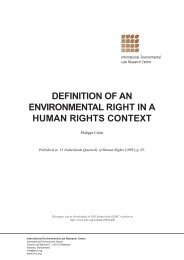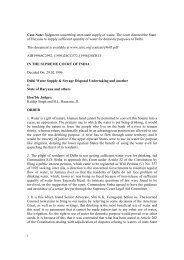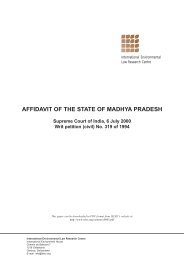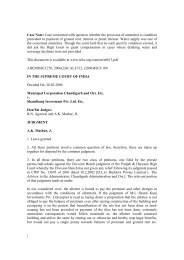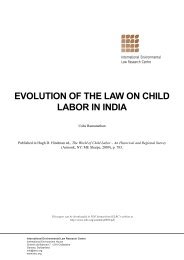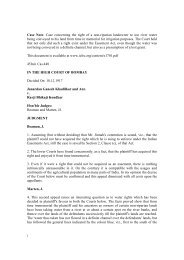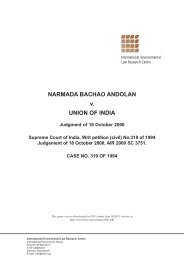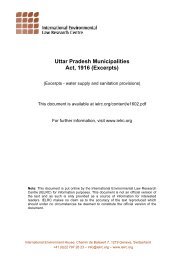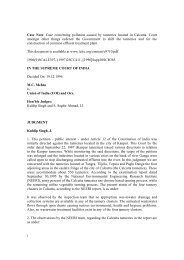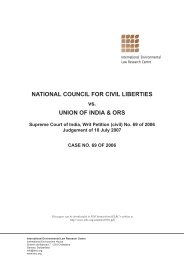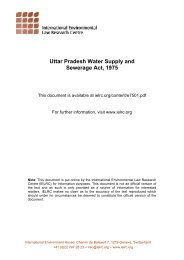Mullaperiyar Environmental Protection Forum v. Union of India (UOI)
Mullaperiyar Environmental Protection Forum v. Union of India (UOI)
Mullaperiyar Environmental Protection Forum v. Union of India (UOI)
- No tags were found...
Create successful ePaper yourself
Turn your PDF publications into a flip-book with our unique Google optimized e-Paper software.
forced to accept it. It was also submitted that under Section 108 <strong>of</strong> the States ReorganizationAct, any agreement or arrangement entered into by Central Government andone or more existing States relating to the right to receive and utilize water can continueto remain in force subject to certain adaptations and modifications as may be agreed uponbetween the successor States. Since there was no such agreement after November 1,1957, the agreement would not continue to remain in force. It also pleaded that theagreements are not covered by Entry 56 <strong>of</strong> List I <strong>of</strong> Seventh Schedule <strong>of</strong> the Constitution<strong>of</strong> <strong>India</strong> and hence Parliament has no power to make any law in respect there<strong>of</strong>.15. On the other hand, the State <strong>of</strong> Taml Nadu seeks directions for raising <strong>of</strong> water levelto 142 ft. and later, after strengthening, to its full level <strong>of</strong> 152 ft. On Section 108 <strong>of</strong> theStates Reorganisation Act, the stand taken by the State <strong>of</strong> Tamil Nadu is that this Section,in pith and substance, deals with "continuance <strong>of</strong> agreements and arrangements relatingto certain irrigation, power or multipurpose projects" and it figures in the Act underwhich the present State <strong>of</strong> Kerala was formed.16. According to the State <strong>of</strong> Tamil Nadu, the Act was not an enactment made in exercise<strong>of</strong> Parliament's legislative power under Entry 56 <strong>of</strong> List I, but was an enactment coveredby Articles 3 & 4 <strong>of</strong> the Constitution <strong>of</strong> <strong>India</strong> which provides for formation <strong>of</strong> new Statesand making <strong>of</strong> supplemental, incidental and consequential provisions. The pre-existingcontractual obligation was reasserted and reaffirmed by the State <strong>of</strong> Kerala after itsformation by signing fresh agreements in 1970. It is also urged that the Lists in ScheduleSeven have no applicability as the point in issue is governed by Articles 3 & 4 <strong>of</strong> theConstitution <strong>of</strong> <strong>India</strong>.17. Another contention urged for the petitioner is that in the light <strong>of</strong> later development <strong>of</strong>law, the agreement <strong>of</strong> 1886 stands frustrated. It was submitted that the lease land wasdeclared as reserve forest in the year 1899 by the erstwhile State <strong>of</strong> Travancore under theTravancore Forest Act. The notification remained in force under Sub-section (3) <strong>of</strong>Section 85 <strong>of</strong> the Kerala Forest Act, 1961. In 1934, Periyar Wildlife Sanctuary had beendeclared as a 'sanctuary' covering the grassy area, marshy areas, swamps <strong>of</strong> <strong>Mullaperiyar</strong>Dam which was expanded to 777 sq. kms. under the Wild Life <strong>Protection</strong> Act, 1972.Taking into account its importance as a well known habitat <strong>of</strong> tigers which is a highlyendangered species, the sanctuary has been declared as "Periyar Tiger Reserve" in 1978under the special management programme known as 'Project Tiger'. It was said to be theoldest sanctuary in the State <strong>of</strong> Kerala which played a very important role in bio-diversityconservation in Western Ghats. International <strong>Union</strong> for Conservation <strong>of</strong> Nature andNatural Resources (IUCN) has declared it as a bio- diversity hot spot. According to thepetitioner, the forest land immediately above the present maximum water level at 136 feethas special significance from bio-diversity point <strong>of</strong> view as it comprises different types <strong>of</strong>habitats like grassy areas, marshy areas, swamps and areas covered with trees. These arethe prime habitats used by most <strong>of</strong> the wild animals especially larger herbivores,carnivores and amphibians. The birds like darter and cormorants nest on the tree stumpswhich stand out distributed in the reservoir. Raising <strong>of</strong> water level would submerge thesestumps and upset the nesting and reproduction <strong>of</strong> birds. The submergence <strong>of</strong> the forestabove 136 ft. would adversely affect the bio-diversity therein and in the neighbouring6



